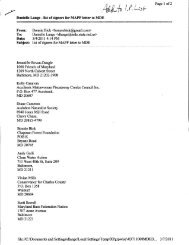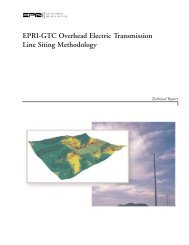Mid-Atlantic Power Pathway Chalk Point Substation to Indian River ...
Mid-Atlantic Power Pathway Chalk Point Substation to Indian River ...
Mid-Atlantic Power Pathway Chalk Point Substation to Indian River ...
Create successful ePaper yourself
Turn your PDF publications into a flip-book with our unique Google optimized e-Paper software.
<strong>Mid</strong>-<strong>Atlantic</strong> <strong>Power</strong> <strong>Pathway</strong> Environmental Review Document<br />
<strong>Chalk</strong> <strong>Point</strong> <strong>Substation</strong> <strong>to</strong> <strong>Indian</strong> <strong>River</strong> <strong>Substation</strong> Volume II – Environmental Analysis of<br />
April 13, 2011 <strong>Chalk</strong> <strong>Point</strong> <strong>Substation</strong> <strong>to</strong> MD/DE State Line<br />
Table 1.2-1 (continued)<br />
Soil Series Within the Project Right-of-Way and Project Boundaries<br />
Soil Series Description<br />
Evesboro The Evesboro series consists of very deep excessively drained soils on uplands. They<br />
formed in acid sandy Coastal Plain sediments. Typically these soils have a grayish<br />
brown sand surface layer 3 inches thick and a yellowish brown sand layer from 3 <strong>to</strong> 16<br />
inches. The subsoil between 16 <strong>to</strong> 30 inches is yellowish brown sand. The substratum<br />
from 30 <strong>to</strong> 72 inches is loose yellowish brown sand. This soil is excessively drained.<br />
The slowest permeability within 60 inches is moderately rapid. Available water capacity<br />
is very high and shrink swell potential is low. This soil is not flooded and is not ponded.<br />
The water table is deeper than 6 feet. There are no saline horizons. This component is<br />
not a hydric soil.<br />
Fallsing<strong>to</strong>n The Fallsing<strong>to</strong>n series consists of very deep poorly drained soils on upland flats and in<br />
depressions. They formed in stratified Coastal Plain sediments of marine or alluvial<br />
origin. Typically these soils have a dark gray sandy loam surface layer 10 inches thick.<br />
The subsoil, from 10 <strong>to</strong> 40 inches is mottled gray sandy clay loam <strong>to</strong> 32 inches and<br />
mottled light gray loamy sand <strong>to</strong> 40 inches. The substratum is stratified light gray sandy<br />
clay loam and sand. This soil is poorly drained. The slowest permeability within 60<br />
inches is moderately slow. Water movement in the most restrictive layer is moderately<br />
high for the ‘Fallsing<strong>to</strong>n, drained’ and ‘Fallsing<strong>to</strong>n, undrained’ components. Available<br />
water capacity is very high and shrink swell potential is low. This soil is not flooded and<br />
is not ponded. The <strong>to</strong>p of the seasonal high water table is at 6 inches. The soil for the<br />
‘Fallsing<strong>to</strong>n, drained’ component is rarely ponded, and the <strong>to</strong>p of the seasonal high<br />
water table is at 14 inches. The soil for the ‘Fallsing<strong>to</strong>n, undrained’ component is<br />
occasionally ponded, and the <strong>to</strong>p of the seasonal high water table is at 5 inches. There<br />
are no saline horizons. This component is a hydric soil.<br />
Fine-loamy Aquic<br />
Paleudults<br />
No information available.<br />
Fluvaquents The Fluvaquents series consists of very deep nearly level, poorly drained soils on long<br />
narrow floodplains. Depth <strong>to</strong> a root restrictive layer is greater than 60 inches.<br />
Permeability is moderate and available water holding capacity is low. Water movement<br />
in the most restrictive layer is moderately high. Available water <strong>to</strong> a depth of 60 inches<br />
is moderate. Shrink-swell potential is low. This soil is frequently flooded. It is not<br />
ponded. The <strong>to</strong>p of the seasonal high water table is at 6 inches. Organic matter content<br />
in the surface horizon is about 4 percent. This soil meets hydric criteria.<br />
Fort Mott The Fort Mott series consists of very deep well drained soils on uplands. They formed in<br />
acid moderately coarse textured Coastal Plain sediments. Typically these soils have a<br />
loamy sand surface layer about 30 inches thick. The <strong>to</strong>p 8 inches is dark grayish brown<br />
loose loamy sand and the lower part from 8 <strong>to</strong> 30 inches is yellowish brown loose loamy<br />
sand. The subsoil from 30 <strong>to</strong> 49 inches is yellowish brown sandy loam. The substratum<br />
from 49 <strong>to</strong> 65 inches is strong brown loose loamy sand. This component is greater than<br />
60 inches thick. Permeability is moderate, and available water holding capacity is<br />
medium. A water table when present is greater than 6 feet. This soil is not flooded and is<br />
not ponded. This component is not a hydric soil.<br />
1-18




